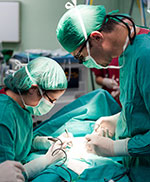![]()
Parkinson's Disease
Facts | Symptoms | Causes | Treatment options
Facts
Parkinson’s disease is a nervous system disorder that develops as brain cells die or become impaired. These neurons produce a chemical called dopamine that is responsible for transmitting signals among the messenger centers of the brain. Without these key distributors, a chemical imbalance occurs and causes tremor. Almost one million people have been diagnosed with Parkinson’s disease. This chronic disease prevents them from being able to carry out their everyday activities and live the way they’re used to.
Symptoms
Symptoms of Parkinson's disease can include shaky hands, arms, legs or jaw, stiffness of the limbs, slow movements and impaired balance and coordination.
Causes
Although the exact causes of Parkinson's disease are unknown, a study by The New England Journal of Medicine released in November 2004 unveils that “recent advances in molecular genetics have revealed important genetic influences underlying the development of the disorder.”
[top]
Treatment
Medications are often helpful in relieving symptoms associated with Parkinson’s disease. However, they have been known to lose their effect over time and have strong side effects. Although surgery is not always the best option for victims of Parkinson’s disease, several treatment options are being increasingly explored with the advancement of new surgical techniques.
Deep brain stimulation
Deep brain stimulation has been cited as one of the most promising therapies for movement disorders in years. This procedure stimulates certain cells in the deep brain structures that are involved in the motion control of the body. Small electrodes placed in the brain connect to a device that provides constant, high-frequency electric energy to the cells. This treatment helps restore the chemical imbalance and suppress tremor.
Pallidotomy and thalamotomy
These treatment methods aim at destroying certain brain tissue that is causing the imbalance. A wire probe is inserted into the brain and transmits radio waves that heat the targeted area and destroy it.
[top]








